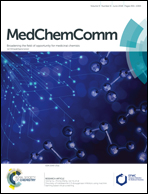Synthesis and cellular penetration properties of new phosphonium based cationic amphiphilic peptides†
Abstract
A new category of phosphonium based cationic amphiphilic peptides has been developed and evaluated as potential antimicrobial peptides and cell penetrating peptides. The required building blocks were conveniently accessible from cysteine and could be applied in a solid phase peptide synthesis protocol for incorporation into peptide sequences. Evaluation of the antimicrobial properties and cellular toxicity of these phosphonium based peptides showed that these “soft” cationic side-chain containing peptides have poor antimicrobial properties and most of them were virtually non toxic (on HEK cells tested at 256 and 512 μM) and non-haemolytic (on horse erythrocytes tested at 512 μM), hinting at an interesting potential application as cell penetrating peptides. This possibility was evaluated using fluorescent peptide derivatives and showed that these phosphonium based peptide derivatives were capable of entering HEK cells and depending on the sequence confined to specific cellular areas.



 Please wait while we load your content...
Please wait while we load your content...